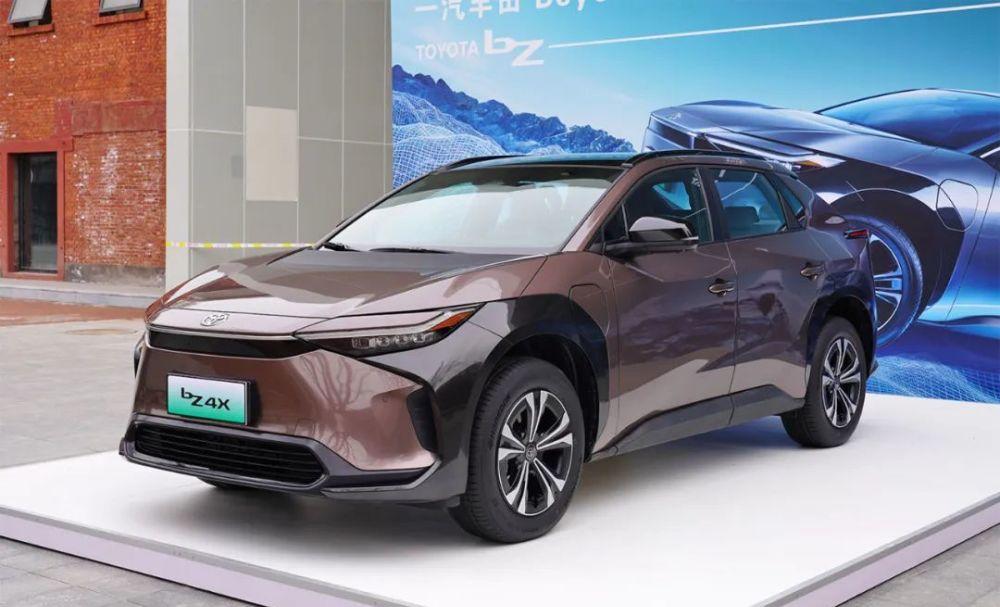Nowadays, the domestic new energy vehicle market can be described as lively and tight, whether it is the traditional car companies changing lanes, or the emergence of new car-making forces, the entire market is filled with the smell of gunpowder. Today we will experience what kind of excellence FAW Toyota bZ4X has.

The letters b and Z in the bZ4X name are the abbreviations for Beyond Zero, which translates to Chinese is Beyond Zero Emissions. 4 is the size C-High, X is the body type SUV meaning.
In terms of appearance, the new car adopts the closed shape commonly found in new energy models, and the narrow headlights on both sides are composed of four light groups, and the overall shape is very fierce. At the same time, the model photographed this time does not use Toyota's blue background Toyota logo representing the identity of new energy.
In terms of details, the front face of the new car adopts a large number of contrasting designs, the bottom bumper is wrapped in black material, and the central part is embellished with chrome decorations, making the new car look more fashionable and refined.
In terms of body size, the new car has a length, width and height of 4690/1860/1650mm, and a wheelbase of 2850mm. The new car is positioned as a compact car, which can be called more than enough compared to the competitors.
On the side of the body, the new car uses the more popular floating roof to make the new car more youthful and stylish. It is not surprising to see hidden door handles on new energy models, but toyota bZ4X still chooses to use traditional door handle design.
In terms of tires, the new car does not adopt the same 20-inch double five-frame wheel design as the overseas version of the model, but is equipped with 18-inch double-width wheels. At the same time, the personalized blue calipers were not displayed on the new car, but used the same silver calipers as the ordinary model.
Coming to the rear of the car, the new car is very consistent with the design of the front of the car, and the design of the lines is still sharply defined. The rear windshield with a large rear inclination has a tail wing design above and below, and the exaggerated diffuser at the lower part optimizes aerodynamics.
Walking into the car can be said to be a new look, which is very different from the interior of previous Toyota models. For the first time, Toyota has adopted an overhead instrument panel position design, which allows the driver to see the dashboard directly from above the steering wheel. At the same time, the front of the center console of the new car is made of weaving material, and the center console is made of piano paint material, which creates a warm atmosphere for the whole car.
In terms of configuration, the new car is equipped with a solar charging dome in the top version, which can absorb about 1800 km of energy per year. The static display model on the spot is not a top-of-the-line model, and adopts a segmented sunroof design. At the same time, the new car will also be equipped with automatic parking, wireless charging external power supply, kick induction electric tailgate and other functions.
Compared with the previous "oil to electricity" model, the bZ4X based on e-TNGA is more reasonable in body structure, and the battery pack arranged in the chassis is well-shaped, and there is less encroachment on the occupant space.
In terms of power, the new car will provide two power forms: front-drive and four-wheel drive, the front-drive version of the motor maximum power of 150kW (204Ps), 0-100km/h acceleration of 8.4 seconds, the four-wheel drive version of the front and rear motor maximum power of 80kW (109Ps), 0-100km/h acceleration of 7.7 seconds.
In terms of battery life, Toyota bZ4XbZ4X is equipped with a lithium-ion battery pack jointly developed with CALT CATL and produced in Toyota's exclusive production line, with a battery capacity of 71.4kWh. The single-motor front-drive version of the WLTC has a range of 500 km and the dual-motor four-wheel drive version has a range of 460 km. Among them, the dual-motor version of the four-wheel drive system is jointly developed and built by Toyota and Subaru.